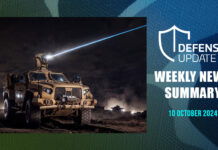Semi-Active Laser (SAL) guidance techniques combine very high precision, with “man-in-the-loop” capability. Weapon’s sensors, utilizing SAL to detect a coded laser spot which is created by a target designator illuminating the target. The laser spot clearly marks the target to an aerial attacker or guided weapon.
Coordination can be achieved at “speed of light”, without requiring lengthy transfer of coordinates which is susceptible to errors. Laser guided weapons can also be used effectively in urban terrain. However, constant lines of sight between the target, laser designator and the weapon must be maintained. Ground designation and UAV designation provide effective support for laser targeting. Ground designation is effective when vertical targets (walls, doors and windows in buildings) are engaged while UAVs or other aerial platforms can take advantage of the unobstructed view of the scene. UAVs and airborne designators become very efficient when engaging moving cars, which can be hidden from ground observers behind other vehicles, buildings or trees. Airborne designators can also designate combatants hidden behind walled patios or in orchards, etc. However, due to their high aspect angle, they are limited in the targeting of vertical surfaces, such as windows or doors. Except for line of sight verification and allocation of codes prior to the mission, the use of SAL does not impose further limitations or complexities when operating in good visibility conditions, (day or night) and therefore it is suitable for ad-hoc engagements of targets of opportunity and close air support. Modern laser guided weapons are integrating both GPS and laser guidance capability, offering high precision, all-weather attack capability.
Laser guided weapons are adversely affected by visibility conditions (clouds, smoke etc) and obscurants. There are also operational limitations on the flight envelopes which have to be flown, exposing aircraft and helicopters to anti-aircraft weapons. When deployed or designated from standoff range, laser guided weapons usually reach the target at flat angles, which do not have sufficient vertical velocity for deep penetration of flat structures (such as underground bunkers). Therefore, such weapons are preferably dropped from shorter distances and high altitude, or through a “loft” maneuver to maintain steep attack angles and high penetration speed.
















